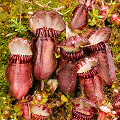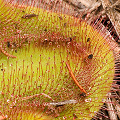Q: What nutrients are carnivorous plants looking for?

Cephalotus

D. erythrorhiza
A: This is a surprisingly complicated question. Ask me when I am in a hurry, and I will just say they
are seeking nitrogen. But it is more complicated. Recall that there are more than 650 species of carnivorous plants,
so why should we assume they are all
foraging for the same nutrients? Different habitats have different nutrient deficiencies, after all.
Insect bodies consist of about 10.5% nitrogen, 3.2% potassium, 2.3% calcium, 0.6% phosphorous, 0.09% magnesium, and 0.02% iron.
And what do the plants want? Cephalotus, Drosera, Nepenthes,
Pinguicula, Sarracenia, and Utricularia seek nitrogen,
but the amount of nitrogen in their
tissues that originated from prey ranges from 20-75%, depending upon the plant species.
Sarracenia also are known to absorb phosphorous, while Utricularia and
Triphyophyllum value the magnesium and potassium in prey.
Studies suggest that the nutrients that
Aldrovanda and at least some species of Utricularia are used to build new tissues,
as opposed to supporting photosynthesis.
I suspect that a complete list of all the nutrients and micronutrients that carnivorous plants are extracting from their prey would
be a very large, messy database. But it would be interesting to see.
Page citations: Adamec, L. 2008; Barthlott, W. et al. 2007;
Juniper, B.E. et al. 1989.